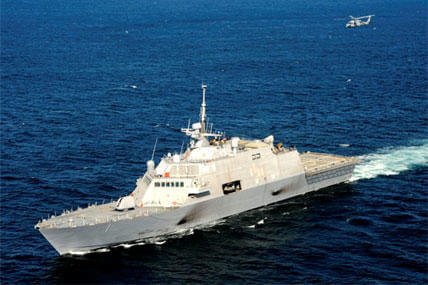The U.S. Navy is considering a program review of the Littoral Combat Ship, a vessel that many argue is too lightly armed for sea warfare, but some experts say the sea service could arm LCS with more punch without a costly redesign.
The futuristic ship has become an easy target for critics for its frequent delays and cost over runs since the program was launched in early 2002.
The LCS class consists of two variants. The first of the USS Freedom variants was delivered in September 2008, and the first USS Independence variant was delivered in December 2009. Lockheed Martin makes the mono-hulled Freedom ships. Austal USA builds the aluminum trimaran-hulled Independence ships.
The Navy plans to build 52 LCS ships, but the $500 billion in Pentagon spending cuts under sequestration will likely force the service to rethink that plan.
The Navy is currently considering a plan to cut its LCS order in half and possibly settle on either the Freedom-class or the Independence-class designs, according to a classified report late last year called "Vision for the 2025 Surface Fleet," Defense News reports.
Navy leaders plan to discuss the LCS and its fit in the future fleet at the Sea Air Space Symposium sponsored by the Navy League set to start April 8 at National Harbor, Md.
So far, the Navy has praised the accomplishments of LCS. The service deployed the LCS 1 Freedom-class ship in 2009 to Southern Command's area with a Helicopter Sea Combat Squadron 22 detachment and a U.S. Coast Guard Law Enforcement Detachment. LCS Freedom and its crew successfully conducted four drug seizures, netting more than five tons of cocaine, detained nine suspected drug smugglers, and disabled two "go-fast" drug vessels, according to Navy officials.
But some in the Pentagon doubt that light-weight LCS design can survive in a real combat situation, J. Michael Gilmore, the Defense Department's director of operational test and evaluation, wrote in a January report.
This concern puzzles Jan van Tol, a senior fellow at the Center for Strategic and Budgetary Assessments.
The Navy has always maintained a "mantra of no losses. … Well if you are ever in a war, that's nonsense. There is going to be attrition; you are going to lose things," van Tol, a retired Navy captain, said. He added that even if a ship is knocked out, most or all of the crew can still survive.
"It's not like an anti-ship missile or a cruise missile would hit a smaller ship like LCS and it would simply vaporize," van Tol said. "That's not going to happen."
The other concern is that the LCS is too lightly armed. The LCS is armed with 57mm naval gun system capable of firing 220 rounds a minute at ranges out to nine miles. LCS also is equipped with an 11-missile launcher for the rolling airframe missile, or RAM, which is intended to knock out incoming anti-ship cruise missiles. It's also armed with .50 caliber machine guns.
An Arleigh Burke Class Aegis destroyer is armed with 56 Tomahawk cruise missiles for both land-attack and anti-ship operations. It has eight Harpoon surface-to-surface missiles and vertical-launch anti-submarine systems, armed with the MK50 or MK46 torpedo. These destroyers are also armed with six 324mm MK32 MOD 14 torpedo tubes.
Experts agree that LCS was never intended to act as a destroyer and could not carry such a vast assortment of weapon systems.
There are, however, offensive weapon systems, such as Harpoon anti-ship missiles, that could be added to LCS without much additional expense.
"One of the things I was surprised about was that they weren't equipped with a couple of two packs of Harpoon missiles," van Tol said. "They don't take up much space … and each one of those platforms represents an ASM threat to the other side. … They could strike other warships such as destroyers."
To van Tol, the Navy should give LCS more time in the fleet before embarking on rethinking the entire program.
"They are not frigates; they are not destroyers," van Tol said. "As you get these things out into the fleet – these new types of platforms – people will try different things with them, and in that way the concepts of operations will be worked out."































